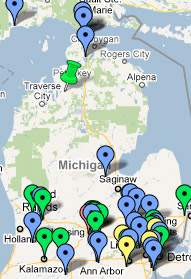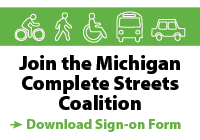Today State Representative Jon Switalski introduced House Resolution 187 to express support for active transportation infrastructure options that promote walking and bicycle usage and reduce childhood obesity. Representative Pam Byrnes also introduced a companion House Concurrent Resolution, HCR 034.
Dubbed the “Complete Streets Resolution”, this piece is the work of a Healthy Kids, Healthy Michigan workgroup, which includes a wide array of advocates working to improve active infrastructure options and reduce childhood obesity. It is the hope of the workgroup that the resolution will help educate lawmakers and citizens about the benefits of active infrastructure. The workgroup also supports the eventual passage of a standalone bill.
Visit the Michigan Legislature website to view the full resolution and see the full list of co-sponsors. And don’t forget to contact your Legislator and urge him or her to support both resolutions.


 Find us on Facebook
Find us on Facebook Follow us on Twitter
Follow us on Twitter







4 comments
Comments feed for this article
December 9, 2009 at 2:03 am
Di
Complete Streets is a great idea, but I hope it can be implemented without taking extra lanes away from too many roads. That can sometimes make it worse.
December 11, 2009 at 5:01 pm
League of Michigan Bicyclists
Hi Di,
Thank your for your comment. Road diets, if implemented properly, have been shown to actually reduce congestion, and generally always increase safety for all users of the roadway.
http://www.livablestreets.com/streetswiki/road-diet is a great resource about road diets. I encourage you to review some of the supporting documents that you’ll find there. I’m copying a brief excerpt below from the site about the most common form of a road diet, a four to three lane conversion.
From Four Lanes to Three
The most frequent type of conversion is four lanes to three [1]-Burden], with the middle lane serving as a two-way turn lane (TWTL). Alternatively, the middle “lane” can be a raised median with breaks or left turn pockets for turns. Studies show that road diets involving streets serving up to 23,000 vehicles per day substantially improve safety without significantly reducing roadway capacity. Most road diet projects result in the same or greater traffic volumes, but at a slower speed.
Dan Burden, of Walkable Communities, Inc., notes that virtually every urban community in the U.S. has four lane roads that are overbuilt — in a manner that encourages speeding, documents a number of U.S. and Canadian road diet projects in Road Diets: Fixing the Big Roads. As Burden explains, the capacity of a three-lane road is almost equivalent to that of a four-lane road, because it operates more efficiently, and because left-turning vehicles are removed from the flow of traffic, reducing delay. A well-studied conversion confirms these observations.[2]
Three-lane roads are inherently safer because the speed is set by the most prudent driver, because there is only a single lane of on-coming traffic to monitor when turning left, and because the two directions are separated by the TWTL or median.
May 28, 2010 at 8:51 pm
House Transportation Committee Takes Testimony on Complete Streets « Michigan Complete Streets Coalition
[...] Committee also took testimony from Katherine Knoll of Healthy Kids Health Michigan, before adopting House Resolution 187 and House Concurrent Resolution 034 to express support for active transportation infrastructure options that promote walking and [...]
June 9, 2010 at 8:12 pm
Complete Streets Makes Progress in House « Michigan Complete Streets Coalition
[...] There is exciting news coming in from the Capitol today! The Healthy Kids Healthy Michigan Complete Streets resolutions have passed the House. House Resolution 187 was adopted and House Concurrent Resolution 34 was [...]